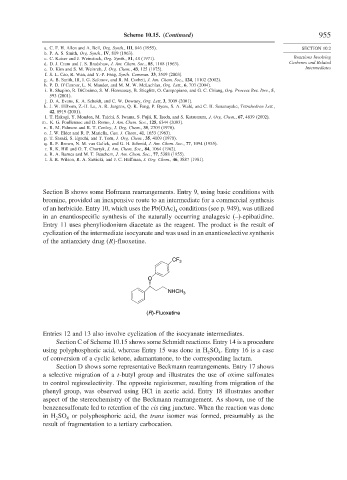Page 979 - Advanced Organic Chemistry Part B - Reactions & Synthesis
P. 979
Scheme 10.15. (Continued) 955
a. C. F. H. Allen and A. Bell, Org. Synth., III, 846 (1955). SECTION 10.2
b. P. A. S. Smith, Org. Synth., IV, 819 (1963).
c. C. Kaiser and J. Weinstock, Org. Synth., 51, 48 (1971). Reactions Involving
d. D. J. Cram and J. S. Bradshaw, J. Am. Chem. Soc., 85, 1108 (1963). Carbenes and Related
e. D. Kim and S. M. Weinreb, J. Org. Chem., 43, 125 (1975). Intermediates
f. S. L. Cao, R. Wan, and Y.-P. Feng, Synth. Commun. 33, 3519 (2003).
g. A. B. Smith, III, I. G. Safonov, and R. M. Corbett, J. Am. Chem. Soc., 124, 11102 (2002).
h. P. D. O’Connor, L. N. Mander, and M. M. W. McLachlan, Org. Lett., 6, 703 (2004).
i. R. Shapiro, R. DiCosimo, S. M. Hennessey, B. Stieglitz, O. Campopiano, and G. C. Chiang, Org. Process Res. Dev., 5,
593 (2001).
j. D. A. Evans, K. A. Scheidt, and C. W. Downey, Org. Lett, 3, 3009 (2001).
k. J. W. Hilborn, Z.-H. Lu, A. R. Jurgens, Q. K. Fang, P. Byers, S. A. Wald, and C. H. Senanayake, Tetrahedron Lett.,
42, 8919 (2001).
l. T. Hakogi, Y. Monden, M. Taichi, S. Iwama, S. Fujii, K. Ikeda, and S. Katsumura, J. Org. Chem., 67, 4839 (2002).
m.. K. G. Poullennec and D. Romo, J. Am. Chem. Soc., 125, 6344 (2003).
n. R. M. Palmere and R. T. Conley, J. Org. Chem., 35, 2703 (1970).
o. J. W. Elder and R. P. Mariella, Can. J. Chem., 41, 1653 (1963).
p. T. Sasaki, S. Eguchi, and T. Toru, J. Org. Chem., 35, 4109 (1970).
q. R. F. Brown, N. M. van Gulick, and G. H. Schmid, J. Am. Chem. Soc., 77, 1094 (1955).
r. R. K. Hill and O. T. Chortyk, J. Am. Chem. Soc., 84, 1064 (1962).
s. R. A. Barnes and M. T. Beachem, J. Am. Chem. Soc., 77, 5388 (1955).
t. S. R. Wilson, R. A. Sawicki, and J. C. Huffman, J. Org. Chem., 46, 3887 (1981).
Section B shows some Hofmann rearrangements. Entry 9, using basic conditions with
bromine, provided an inexpensive route to an intermediate for a commercial synthesis
of an herbicide. Entry 10, which uses the Pb(OAc) conditions (see p. 949), was utilized
4
in an enantiospecific synthesis of the naturally occurring analagesic (–)-epibatidine.
Entry 11 uses phenyliodonium diacetate as the reagent. The product is the result of
cyclization of the intermediate isocyanate and was used in an enantioselective synthesis
of the antianxiety drug (R)-fluoxetine.
CF 3
O
NHCH 3
(R)-Fluoxetine
Entries 12 and 13 also involve cyclization of the isocyanate intermediates.
Section C of Scheme 10.15 shows some Schmidt reactions. Entry 14 is a procedure
using polyphosphoric acid, whereas Entry 15 was done in H SO . Entry 16 is a case
2 4
of conversion of a cyclic ketone, adamantanone, to the corresponding lactam.
Section D shows some representative Beckmann rearrangements. Entry 17 shows
a selective migration of a t-butyl group and illustrates the use of oxime sulfonates
to control regioselectivity. The opposite regioisomer, resulting from migration of the
phenyl group, was observed using HCl in acetic acid. Entry 18 illustrates another
aspect of the stereochemistry of the Beckmann rearrangement. As shown, use of the
benzenesulfonate led to retention of the cis ring juncture. When the reaction was done
in H SO or polyphosphoric acid, the trans isomer was formed, presumably as the
2
4
result of fragmentation to a tertiary carbocation.

